 17 November 19 The Absurd Difficulty Generating Even a Few Donations
It defies comprehension that it could be so difficult, nearly impossible to generate what few donations Reader Supported News needs to continue serving a community that otherwise seems to appreciate our efforts.
How important can it be to avoid contributing?
Marc Ash
Sure, I'll make a donation!Founder, Reader Supported News Update My Monthly Donation
If you would prefer to send a check:
Reader Supported News PO Box 2043 Citrus Hts CA 95611 |
RSN: Marc Ash | For Trump, It's the White House or the Big House

Marc Ash, Reader Supported News
Ash writes: "There is more than enough evidence to convict Donald Trump on a wide variety of federal and state criminal charges. He is no less guilty than all the other men now going to prison for him, and prosecuting the charges would be no more difficult."

Marc Ash, Reader Supported News
Ash writes: "There is more than enough evidence to convict Donald Trump on a wide variety of federal and state criminal charges. He is no less guilty than all the other men now going to prison for him, and prosecuting the charges would be no more difficult."
From obstruction to campaign finance violations and bribery, the evidence already available far exceeds the legal threshold for indictment and conviction.
Right now, only two things are preventing Trump from being arrested and tried. The first is Attorney General William Barr. Barr, like Rudy Giuliani, is acting as Trump’s personal attorney first and as Attorney General of the United States second, if at all. It is hard to imagine a scenario in which Barr would allow the DoJ to take any formal legal action against Trump, the Fifth Avenue shooting hypothetical notwithstanding. Barr was installed to watch Trump’s back, and he has every intention of misusing his position as Attorney General to do just that.
The second is the oft-cited OLC Memos. The memos in their totality establish as DoJ policy that a sitting president cannot be indicted. Remember, that’s a DoJ guideline, not a constitutional principle or legal determination. Nonetheless, before Trump, the memos were regarded with sacred-cow reverence. Now that the nation is beset by Trump and Trumpism, the courts are finally starting to question the DoJ’s position.
The net effect of all this is that Donald Trump is effectively trapped in the Oval Office. If he leaves the presidency, either by impeachment-mandated removal or resignation, he will be subject to prosecution – and based on the evidence, likely conviction.
Sure, there is a back door. It’s the same one Nixon exited through. Resign and turn the reins of power over to a replacement who would then pardon you. Nixon had Ford, and at least at this stage, Trump has Pence, who would likely do as Ford did.
Caveat! A federal pardon might exempt Trump from federal prosecution, but it wouldn’t do anything to shield Trump or any of his family members from prosecution in state courts. Such states would include New York and Florida, both states in which Trump has long, well-documented histories of creative and eyebrow-raising financial dealings. Specifically, that would include Trump’s own and his family members’ state tax filings, items the state of New York is now actively seeking in a case apparently headed to the Supreme Court. However it’s unlikely that even this ridiculously autocrat-friendly court would find that Trump’s tax returns are beyond law enforcement review. That would be silly, right?
While Barr and the OLC memos may be preventing Trump from being prosecuted while in office, it’s the Republican members of the Senate who are preventing him from being removed from office by impeachment, and they are taking big personal risks to do it.
Others in recent memory have put themselves at personal risk to protect Donald Trump. Such noteworthy figures include his former personal attorney/fixer Michael Cohen, his former 2016 campaign chairman Paul Manafort, his former National Security advisor Michael Flynn, and his 2016 campaign advisor Roger Stone. All of whom are convicted of federal felonies and two of whom are currently serving time in federal facilities.
Republicans in the Senate waiting for the Trump bus to take them to the promised land, the same bus incidentally that appeared in the infamous Access Hollywood video, might want to take a peek under that bus when it pulls up. They’ll notice two things: there are quite a few former Trump loyalists under there, and there’s room for quite a few more.
Marc Ash is the founder and former Executive Director of Truthout, and is now founder and Editor of Reader Supported News.
Reader Supported News is the Publication of Origin for this work. Permission to republish is freely granted with credit and a link back to Reader Supported News.

Bernie Sanders greets supporters at a rally in East L.A. (photo: Genaro Molina/LA Times)
Bernie Sanders' Message Increasingly Resonates With Latino Voters
Mario Koran, Guardian UK
Koran writes: "Numbers from recent polls put Sanders as a heavy favorite among the Latino voters - a bloc that has tremendous sway in determining the outcome of the democratic primary in the state and across the nation."
READ MORE
Mario Koran, Guardian UK
Koran writes: "Numbers from recent polls put Sanders as a heavy favorite among the Latino voters - a bloc that has tremendous sway in determining the outcome of the democratic primary in the state and across the nation."
READ MORE

Activists rallying to defend DACA in Washington, DC. (photo: Andrew Stefan/RSN)
What Happens to DACA Holders if the Supreme Court Allows Trump to End the Program?
Suzanne Gamboa, NBC News
Gamboa writes: "If the Supreme Court rules in Trump's favor, the question is what happens to these hundreds of thousands of young adults."
READ MORE
Suzanne Gamboa, NBC News
Gamboa writes: "If the Supreme Court rules in Trump's favor, the question is what happens to these hundreds of thousands of young adults."
READ MORE

A protest in Puerto Rico. (photo: teleSUR)
How Investigative Journalism Sparked a Revolution in Puerto Rico and Brought Down Governor Rosselló
Democracy Now!
Excerpt: "As anti-government protests rage across the globe, from Chile to Hong Kong to Iraq, we look back at this year's historic demonstrations in Puerto Rico that ousted Governor Ricardo Rosselló in July."
READ MORE
Democracy Now!
Excerpt: "As anti-government protests rage across the globe, from Chile to Hong Kong to Iraq, we look back at this year's historic demonstrations in Puerto Rico that ousted Governor Ricardo Rosselló in July."
READ MORE

A prisoner. (photo: Getty Images)
Speaking Out About Prison Conditions Is Risky. Incarcerated People Do It Anyway.
Vaidya Gullapalli, The Appeal
Gullapalli writes: "The risk prisoners run in speaking out is real."
Vaidya Gullapalli, The Appeal
Gullapalli writes: "The risk prisoners run in speaking out is real."
EXCERPTS:
The DOJ report elaborated on what had come to national attention that month, when more than 2,000 photographs were smuggled out of one notorious Alabama prison and published in various outlets, including the New York Times and Splinter. The pictures, believed to have been shared by a corrections officer at the St. Clair Correctional Facility, showed rampant violence and bloodshed, abysmal medical care, and untreated mental health issues.
The revelations were not new to people in Alabama’s prisons who, Rakia wrote, “have tried to expose this reality for years.”
But as Melissa Brown of the Montgomery Advertiser points out in an article this week, incarcerated people’s own accounts of life inside these places has rarely been sought out or heard in a way that matches their importance. “All too often,” she wrote, “the voices of the people directly affected by the Alabama prison system are not heard.” In fact, “Nearly every day, accounts released by state officials are reported without verification, despite the fact multiple federal institutions have found that [the Alabama Department of Corrections’] own employees have lied in their record-keeping and under-counted violent incidents as severe as murder.”
Brown shares the accounts of multiple men incarcerated in Alabama prisons who spoke up about the degrading, violent conditions in prison. “I have found myself living in hell,” said Wendell Roberts. Another man described the elderly men incarcerated decades after their convictions. “What threat are they to society? I’m talking about people in their 80s. Some of them in here are blind. They have to put their hand on another person’s shoulder to go to the chow hall or the store.”
In New York, the suspicious death of a man in one of the state’s most notorious prisons would not have come to light but for the efforts of incarcerated people to speak about it, despite these risks. Last month, Jan Ransom of the New York Times wrote about the January death of 67-year-old John McMillon, billed as a heart attack by department officials but described as the result of a brutal beating by nine men incarcerated with McMillon who said they witnessed what happened. In a follow-up piece, Ransom described how her reporting was driven by the willingness of people in prison to talk to her, in some cases even allowing her to use names.

A Bolivian indigenous woman, supporter of Bolivian ousted president Evo Morales, holds a Wiphala flag - representing native peoples - during a protest against the interim government in La Paz on November 15, 2019. (photo: Ronaldo Schemidt/AFP/Getty Images)
Bolivia: 9 Corpses in 24 Hours Prove Dictatorship's Violence
teleSUR
Excerpt: "Over the last 24 hours, at least nine Bolivians have died as a result of repressive actions carried out by the security forces that support the coup-based government headed by Senator Jeanine Añez."
teleSUR
Excerpt: "Over the last 24 hours, at least nine Bolivians have died as a result of repressive actions carried out by the security forces that support the coup-based government headed by Senator Jeanine Añez."
EXCERPTS:
"They have killed our brothers as if they were animals," Zubieta said and explained that Añez's regime is generating "a setback of more than 30 years with respect to the protection of people."
Judging by the complaints filed before the Ombudsman's office, far-right paramilitary groups have been activated to "repress and intimidate people even when they are simply walking home from work."
Golpe en Bolivia: La CIDH condenó la masacre de Sacaba | Cinco muertos y decenas de heridos por la represión pagina12.com.ar/231340-golpe-e…
Coup in Bolivia: The Inter-American Commission on Human Rights (IACHR) condemned the Sacaba massacre. Five dead and dozens injured by the repression. After the murder of five protesters, the IACHR reminded the self-proclaimed president of her "obligation to ensure the right to life and physical integrity of those who protest peacefully" and condemned the "disproportionate use of police and military force."
While that was happening, however, the governments of Uruguay, China and Russia have joined the voices that forcefully reject the coup in Bolivia.
#BOLIVIA || Se confirman siete muertos a manos de las fuerzas represoras al servicio de Jeaninne Añez. En medio del dolor el pueblo grita:
"¡Añez Asesina!"
#ElMundoConEvo#GolpeDeEstadoEnBolivia
Bolivia: repressive forces at the service of Jeanine Añez killed 7 people. Amid the pain, the people shout: "Añez, murderer!"

Beluga whales. (photo: Flickr)
Last of the Belugas From Russia's 'Whale Jail' Released
Mongabay
Excerpt: "The last of the nearly 100 whales held captive in what's been termed a 'whale jail' in Russia's Far East have finally been freed back into the ocean - although the releases have been far from ideal, conservationists say."
Mongabay
Excerpt: "The last of the nearly 100 whales held captive in what's been termed a 'whale jail' in Russia's Far East have finally been freed back into the ocean - although the releases have been far from ideal, conservationists say."
Late last year, drone footage revealed 87 beluga whales and 11 orcas packed in cramped, icy pens in Srednyaya Bay. The whales had reportedly been caught by four companies during the summer of 2018, and were allegedly due to be sold to marine parks and aquariums in China.
Following international outrage, Russian President Vladimir Putin intervened and authorities launched an investigation into the capture of the whales. Russian officials also signed a joint agreement with U.S-based nonprofits Ocean Futures Society and The Whale Sanctuary Project in April announcing that all the captive belugas (Delphinapterus leucas) and orcas (Orcinus orca) would be released back into their natural environment.
In June, a court ruled that the whale captures were illegal. Later that month, the first wave of the whale release began. Two orcas and six belugas were moved 1,770 kilometers (1,100 miles) by truck, then transported by boat to the Sea of Okhotsk, from where the mammals had originally been captured. Activists and conservationists, however, at the time criticized the lack of transparency in the release effort and the manner in which the whales were “dumped” into the sea, without a proper rehabilitation process in place. The remaining belugas and orcas continued to be released in batches over the following months.
On Nov. 10, Russian authorities announced that the last of the 50 beluga whales had been released in Uspeniya Bay, in the Primorsky region, about 100 kilometers (62 miles) away from the holding facility. This is not the whales’ native habitat, Jean-Michel Cousteau, president of the Ocean Futures Society, and Charles Vinick, executive director of The Whale Sanctuary Project, said in a joint statement.
“This outcome is not ideal for the belugas, since this is not their normal habitat or the area where they were captured,” the statement said. “Nonetheless, we trust the intention of Russian government authorities to release the belugas, despite limitations due to the availability of ships, inadequate finances, and weather conditions.”
Cousteau and Vinick added that North Korean fishing vessels frequent the area where the belugas have been released, and the whales could be at risk of poaching. They called on the government to monitor the 50 belugas over the short term and the long term.
“We hope that the location will make it possible to carry out regular visual monitoring of the belugas for a full 30 days after release and actively over the first six months after release,” they said in the statement. “We also hope that visual monitoring will help reduce concerns about threats from North Korean fishing vessels that we understand are poaching in the area and that the Russian government will do what is necessary to protect the belugas from repeat capture.”
Russia’s Research Institute for Fisheries and Oceanography (VNIRO) told TASS, a Russian news agency, that it has been monitoring the whales. Some of the belugas are still in Uspeniya Bay, it said, while others have moved away from the points of their release. Some have even migrated up to 40 kilometers (25 miles) away.
“Now, we can say that the animals were set free in good physical condition and are vigorously adapting to the wild, using the opportunities for food available in Uspeniya Bay and along the Primorsky Region coastline,” VNIRO told TASS.
The “Whale Jail” Is No More.
The last belugas were released in the Bay of Uspeniya Lazovsky. The notorious “whale jail” that held 10 orcas & 87 belugas captured for marine parks in China is empty.
The rescue is the largest in history & a remarkable achievement. @Whale_Sanctuary




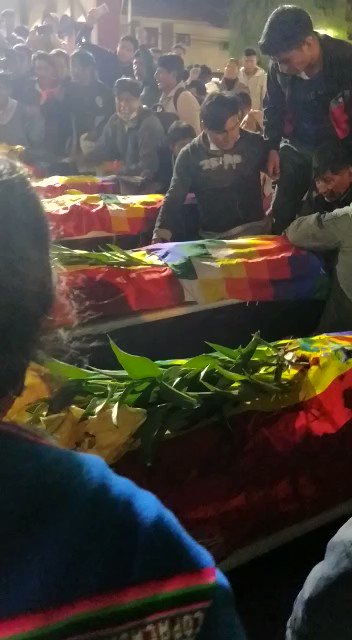

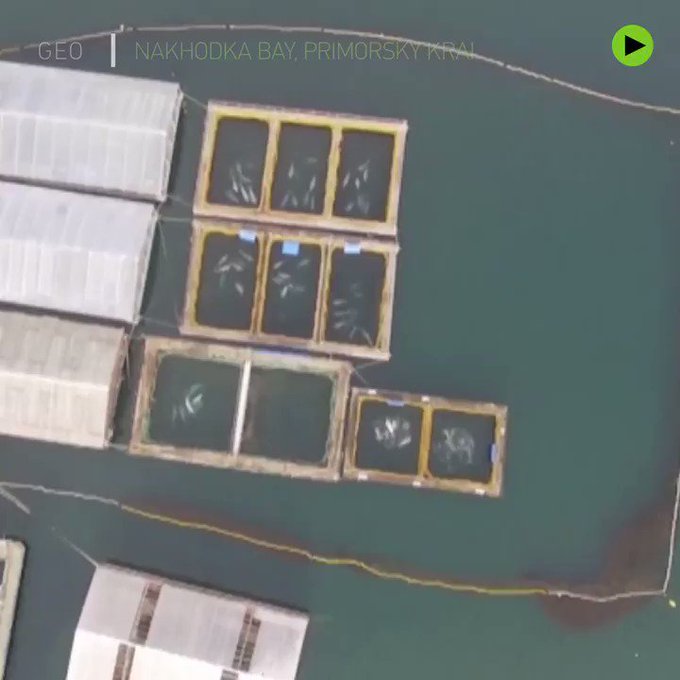

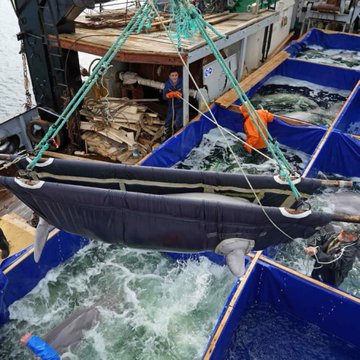
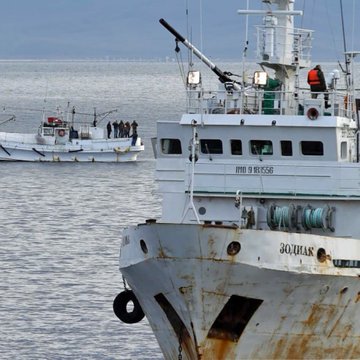
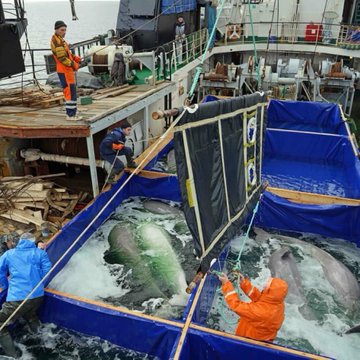

Comments
Post a Comment